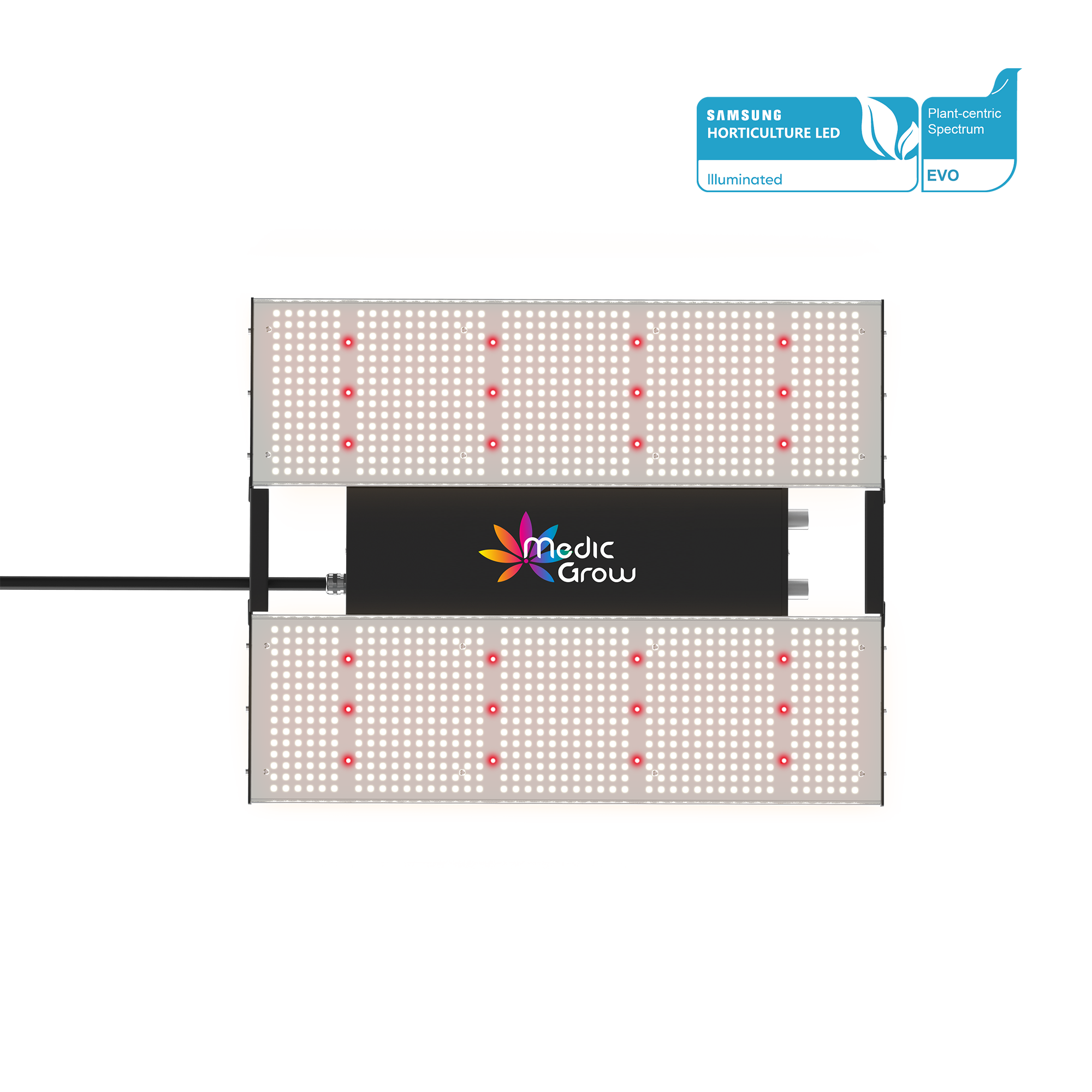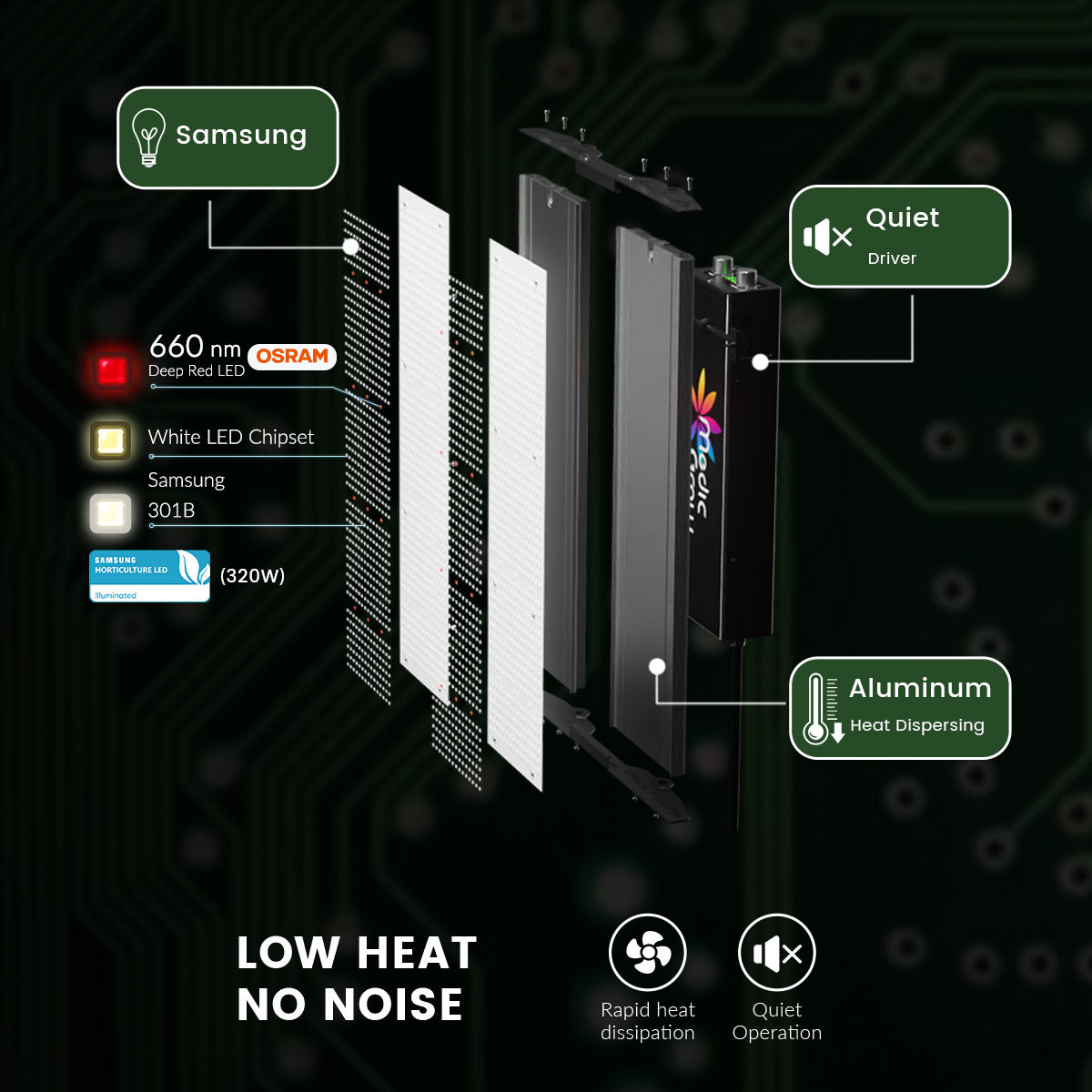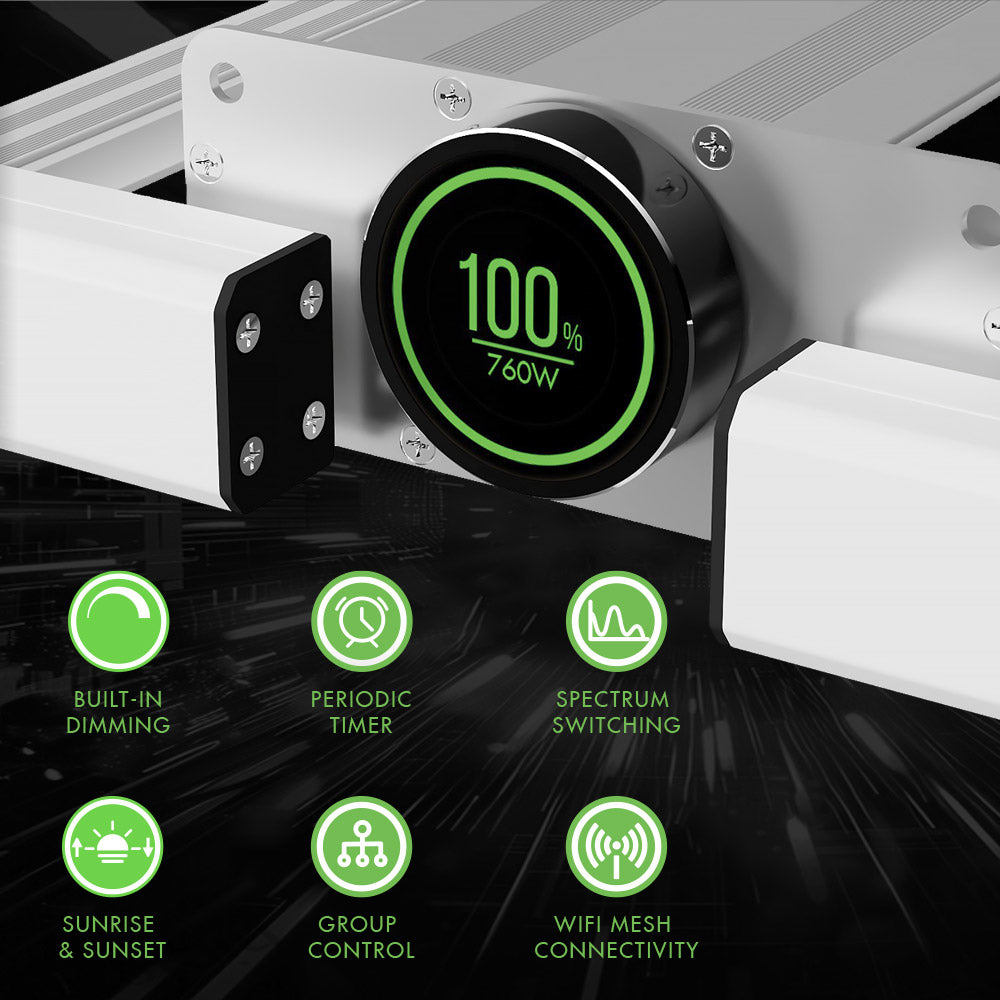新订户可享受9% 折扣

植物生长灯有用吗?如何使用它们才能达到最佳效果
如果您是室内种植者,您可能听说过生长灯- 即使在自然阳光有限的空间中,它也能为植物全年生长提供解决方案。
但它们真的有效吗?哪种生长灯是最好的?如何使用它们才能获得最佳效果?在本指南中,我们将探索生长灯背后的科学原理,它们如何使不同类型的植物受益,并提供有效使用它们的实用技巧。我希望您通过阅读我们的指南可以获得更好的效果。
主要内容:
植物生长灯有用吗
是的,生长灯对于室内园艺和植物栽培非常有效。这些灯专门设计用于复制植物进行光合作用和最佳生长所需的自然光谱。
通过提供适当强度和波长的光,生长灯使您能够在室内培育各种各样的植物,即使在没有阳光的空间或不利的室外条件下也是如此。
不同类型的生长灯,例如 LED、荧光和 HID,可根据您的特定园艺需求提供各种优势,例如能源效率、光谱控制和成本效益。
无论您种植的是绿叶蔬菜、花卉还是较大的作物,选择合适的生长灯都可以显著提高植物的健康和产量。
植物生长灯如何工作
生长灯的工作原理是发射植物进行光合作用所需的特定波长的光。光合作用是植物将光能转化为化学能以促进其生长的过程。
自然阳光包含广泛的光谱,包括蓝光和红光波长,这对植物生命周期的不同阶段至关重要。
生长灯旨在复制该光谱,甚至可以根据植物的生长阶段进行定制以强调某些波长。
- 蓝光(400-500纳米):促进植物生长,帮助植物长出强壮的茎和茂盛的叶子。
- 红光(600-700 nm):刺激开花和果实生产,这在植物发育的开花和结果阶段至关重要。
一些生长灯(例如 Medic Grow NEO-780)允许用户调整光谱以优化不同阶段的植物生长。
例如,您可以在生长阶段使用更多的蓝光,并在开花阶段增加红光。
此外,您还可以调整光源的强度、持续时间和距离,以适应植物的不同生长阶段和不同植物类型的特定光照需求。
简而言之,植物生长灯通过提供必要的光能和光谱,使植物在室内茁壮成长。通过调整光强度、曝光时间和其他设置,您可以优化植物生长,获得更好的效果。
生长灯的类型
LED 生长灯
LED 生长灯节能、耐用,可提供全光谱,因此既可用于植物生长,也可用于开花。SMART -8 PLUS等许多型号还允许调整光谱,因此适合植物生长的所有阶段。
荧光生长灯
荧光灯(例如 T5 或 CFL)散发的热量较少,非常适合较小的植物或狭小的空间。它们是初学者或空间有限的园丁的理想选择,因为它们可以为对光照需求较低的植物提供充足的光照。
高强度放电(HID)生长灯
HID 灯,包括金属卤化物 (MH) 和高压钠 (HPS),可产生强光,非常适合大规模种植业务或需要高光照才能生长的植物,但现在已逐渐被 LED 灯取代。
白炽生长灯
白炽灯价格便宜,但与其他类型的灯泡相比效率较低。它们主要适用于低光照植物,由于其高热量输出和低能效,很少用于严肃的种植。
哪种生长灯最好
LED 植物生长灯因其节能、多功能和全光谱光而被大多数种植者视为最佳选择。LED 植物生长灯具有可调光谱、长寿命和低热量输出等特点,是多种植物的理想选择,包括绿叶蔬菜、草本植物、花卉和果树作物。
如何使用植物生长灯获得最佳效果
为了使用生长灯获得最佳效果,请遵循以下准则:
步骤 1:选择合适的生长灯
正如我们之前提到的,选择合适的生长灯对于满足植物的特定需求至关重要。Medic Grow 等LED 生长灯因其节能、使用寿命更长、能够提供全光谱、支持植物各个阶段的生长,是大多数室内园丁的热门选择。
另一方面, HPS(高压钠)灯通常是开花阶段的首选,因为它们发出更高强度的红光,促进更好的花朵生产。
荧光灯(例如 T5 或 CFL)非常适合幼苗和幼苗,因为它们提供柔和、易于控制的光线,可促进早期健康生长而不会造成压力。选择合适的生长灯可确保您的植物获得最合适的光强度和光谱,以实现最佳生长。
第 2 步:正确放置灯光
生长灯与植物之间的距离对于避免光灼伤或光照不足至关重要。LED生长灯通常应放置在植物冠层上方 12-24 英寸处,具体取决于光的强度和瓦数。有关更多详细信息,请阅读: LED 生长灯应与植物保持多远?
荧光灯可以放置在离植物较近的地方,大约在植物上方 6-12 英寸处,因为它们散发的热量较少。密切关注植物的反应,随着植物的生长调整高度以保持适当的平衡。
步骤 3:设置光照持续时间
植物每天接受的光照量取决于其生长阶段。对于大多数植物来说,每天光照12-16 小时效果良好。幼苗和幼苗每天需要大约 16-18 小时的光照才能促进其健康、旺盛地生长。
当植物过渡到开花阶段时, 12 小时光照和 12 小时黑暗是促进花朵发育的理想选择。使用计时器有助于自动完成此过程,确保您的植物不受干扰地获得持续的光照。
另请阅读:生长灯应亮多长时间?
步骤 4:监测光谱
生长灯发出的光谱对植物生长起着重要作用。全光谱 LED 灯旨在模拟自然阳光,涵盖植物光合作用所需的所有波长,从蓝光到红光光谱。
在生长阶段,植物受益于更多的蓝光(400-500nm),这有利于叶子的强劲生长、茎干的粗壮以及植物的整体结构。当植物进入开花阶段时,切换到发出更多红光(600-700nm)的灯,以促进开花和结果。
值得注意的是,Medic Grow 的SPECTRUM-Y系列提供四种可调节光谱,包括可定制的红光和蓝光,以及紫外线和远红光,可最大限度地促进植物生长。
此外,这款生长灯已通过ETL 和 DLC 认证,他们的团队将协助您获得大量折扣,让您可以零成本购买大量生长灯!欲了解更多信息,请访问 Medic Grow商用生长灯。
第五步:保持温度和通风
生长灯可以提高种植空间内的温度,如果管理不当,会影响植物的生长。使用温度计和湿度计监测种植室或帐篷内的温度和湿度。
大多数植物的理想温度范围是白天68-77°F (20-25°C) ,晚上略低。高湿度也会促进霉菌的生长,因此请根据植物的生长阶段将湿度保持在40-60%之间。
通过遵循这些步骤,您可以最大限度地发挥生长灯的优势,帮助室内植物茁壮成长。无论您在室内种植什么植物,这些技术都是实现强劲、健康生长和更高产量的关键。
结论
如果使用得当,生长灯是室内植物生长的有效解决方案。请记住监测光谱、持续时间、温度和通风,以获得最佳效果。使用正确的技术,生长灯将增强您的室内花园,促进每个阶段的植物蓬勃发展。
与植物生长灯是否有效相关的常见问题解答
1. 生长灯真的有用吗?
是的,植物生长灯确实有效,尤其是对于室内园艺来说。它们提供支持光合作用所需的光谱,促进植物健康生长。例如,LED 植物生长灯具有节能效果,并且提供模拟阳光的全光谱。
2. 任何 LED 灯都能滋生植物吗?
并非所有 LED 灯都能促进植物生长。普通 LED 灯泡缺乏植物所需的全光谱光,尤其是生长和开花所必需的红光和蓝光波长。LED 生长灯可提供均衡的光谱和足够的强度,以满足植物的需求。
3. 哪种 LED 最适合植物生长?
最适合植物生长的 LED 是全光谱 LED 生长灯,它模拟自然阳光并支持植物生长的所有阶段。热门选择包括 MedicGrow,它效率高、光强度和光谱可定制,并且更节能。
特色产品
博客文章

Behind the Glow: The Science of Precision in Every Medic Grow Light

Medic LED Grow Lights: Leading the way in horticultural lighting standards

🌱 LED Grow Lights: A Hardware Engineer’s Buying Guide

- led grow light
💡 Top + Bottom Grow Lights: The Future of Precision Cultivation
如有任何想法请联系我们!
- 选择一个选项会导致整个页面刷新。
!




























